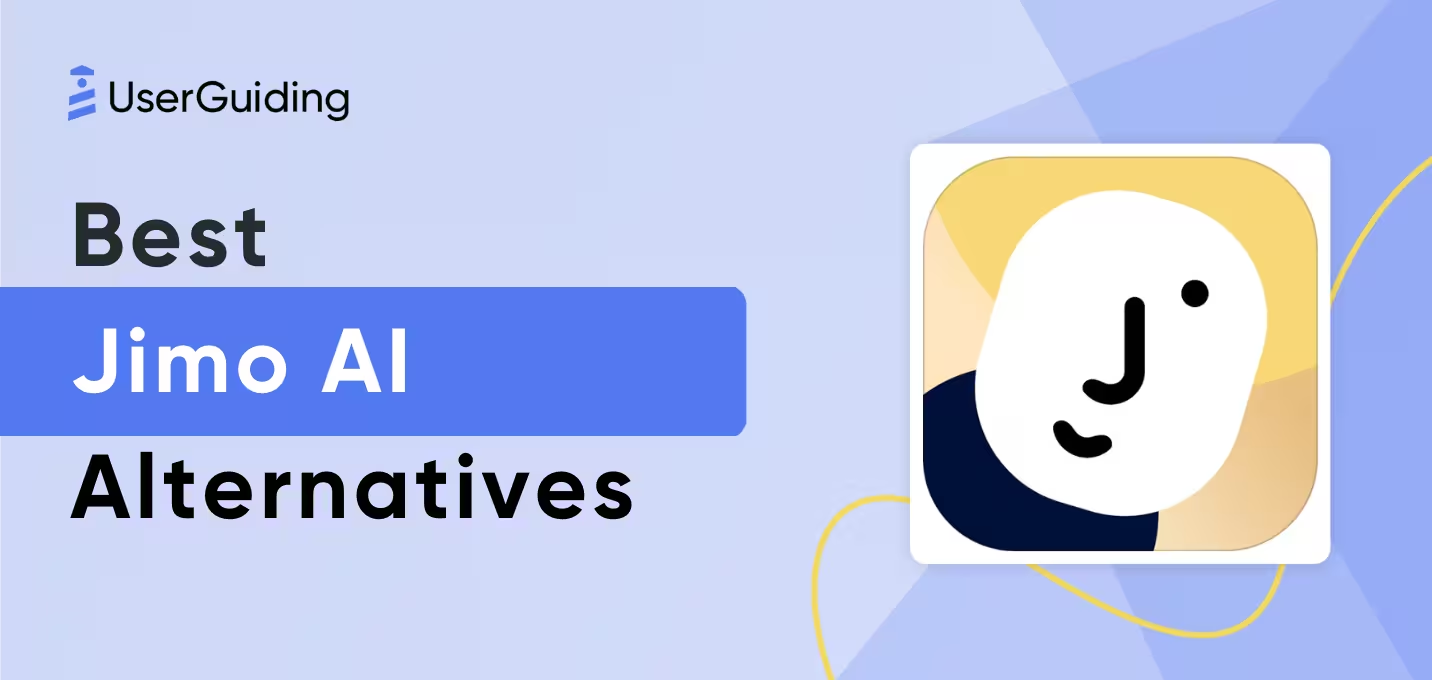

When pricing pages are vague and real customer feedback is scattered across Reddit threads, G2 reviews, and anonymous Vendr comments, figuring out what you're actually paying for becomes a time-consuming guessing game.
And the higher the price, the more frustrating that lack of transparency feels, especially when the value doesn’t scale with the cost.
In this article, we’re cutting through the noise.
You'll find real user insights on Chameleon’s pricing, plans, and features, plus the hidden challenges that come with high-cost tools.
We'll break down how Chameleon’s pricing tiers stack up, what you really get for what you pay, and whether there’s a better, more cost-effective alternative out there.
Here we go!
TL;DR
- Chameleon is a product adoption platform for building in-app experiences, user flows, announcements, and surveys using either pop-up modals or embedded cards.
- With their $279/mo Startup plan, the pricing only goes higher and according to Vendr, the average annual cost exceeds $30,000.
- Is it worth it? That depends. Chameleon has standout features like embeddable widgets, but also comes with a steep learning curve, slower implementation, and limited modern functionality.
- If you need something easier, faster, and more feature-rich, an alternative like UserGuiding may be a better option.
- UserGuiding is fully no-code, quick to launch, highly customizable, and offers advanced segmentation and support tools.
- It’s also more cost-effective, transparent, and scalable with clear MAU-based pricing. Start your free trial and see the difference for yourself.
What is Chameleon?
Chameleon is a product adoption platform that enables you to offer personalized user experiences through pop-up modals and embeddable elements.
The platform focuses exclusively on in-app user experiences and provides detailed solutions for onboarding, contextual guidance, self-serve support, user engagement, and communication directly within your product.
Here are the features and capabilities it offers:
- Product Tours
- Modals
- Banners
- Embedded Cards
- Tooltips
- Checklists
- Resource Centers
- NPS & Microsurveys
- CMD+K Search

The platform supports web-based apps only.
What is Chameleon used for?
Chameleon is an in-app experience-focused product adoption platform, not an all-in-one product adoption solution. So there are no emails, push notifications, knowledge bases, or changelogs.
However, it doesn’t mean its use cases are limited.
You can still use Chameleon for:
- User onboarding and in-app guidance: Product tours, checklists, and embedded cards help you create goal-oriented and personalized interactive demos or user flows. These experiences guide your users toward the “Aha!” moment as quickly and easily as possible.
- In-app communication and product announcements: You can use modals, banners, and embedded cards to announce updates, releases, and enhancements directly within your platform. These elements help you capture the attention of active users.
- Feature discovery and adoption: In addition to announcements, you can use tooltips and hotspots to encourage users to explore new features. You can also offer helpful tips to improve their experience and support adoption of specific features.
- Self-serve in-app support: While Chameleon does not provide a native knowledge base, you can integrate your existing one with a resource center built in Chameleon. This makes help materials easily accessible within your platform. The CMD+K Search feature allows users to search all support resources from one place. It can also offer AI-generated summaries and quick answers.
- User feedback and research: Using NPS surveys and microsurveys, you can collect feedback on features, user interface, user experience, and bugs. You can also assess overall user satisfaction. This data helps you make informed decisions and prioritize product updates based on real user input.
- User behavior and engagement monitoring: Chameleon allows you to create custom events and track engagement with in-app content. You can use the analytics dashboard to monitor user interactions and measure the effectiveness of your experiences.
How much is Chameleon?
Chameleon has 3 paid plans: Startup, Growth, and Enterprise.
Chameleon's Startup plan starts at $279/mo. But how does that price scale with more MAUs, additional seats, or if you switch to an annual contract? Your guess is as good as ours, as there’s no pricing calculator or estimator anywhere on their site.
Growth and Enterprise?
Growth plan starts from $12,000 and is billed yearly. How the price scales up with more MAUs is still unknown.
For Enterprise, Chameleon doesn’t even bother to list its starting prices. It’s all behind the “Let’s Talk” curtain.
However, based on the Vendr data, the average customer pays around $30,720 per year to use Chameleon. So yeah, that’s about $2,560/month, a far cry from the $279/month entry point of the Startup plan…
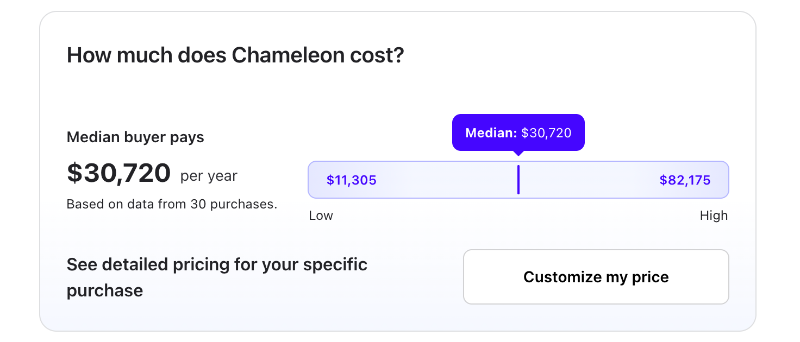
🗒️ On a side note, Chameleon does offer a free plan called HelpBar, but calling it a “plan” might be a stretch. It’s really just one feature: CMD+K Search.
With HelpBar, you get access to the CMD+K Search bar, help center integrations to power the search, and AI-generated answers. That’s it. None of the other core features related to in-app experiences (like tours, tooltips, or banners) are included.
So while it’s free, it’s more of a limited utility than a true entry-level plan.
Even if your use case is in-app support, the free HelpBar plan won’t cut it. You’ll need a paid plan to unlock essentials like the Resource Center, engagement analytics, and any meaningful customization.
You should also know that Chameleon does offer a free plan called Demos Free. However, as its name suggest, this planonly offers limited features and is merely a trial module of Chameleon.
Demos Free plan includes unlimited product-connected interactive demos, engagement tracking and webhooks (single use).
Unfortunately, the high costs and plan limitations aren’t the only issues with Chameleon’s half-transparent, half-opaque pricing.
According to (former) customer reviews on G2, Reddit, and Vendr community notes, here’s what tends to frustrate users about Chameleon’s pricing and contract process:
- Inconsistent pricing between customers: Not only the Grotwth and Enterprise prices are unclear, and apparently, they’re not exactly fixed on Chameleon’s side either.
According to customer insights from Vendr, pricing often comes down to your negotiation skills. If you know how to play hardball, you can score significant discounts.
But if you’re not exactly a pro at pushing back (or you can’t make your hesitation feel like a threat) you might end up paying a lot more than someone else on practically the same plan.
This lack of standardization can seriously undermine the trust and confidence you have in the platform.

- Rush discounts: Like many SaaS companies, Chameleon offers discounts for upgrades or renewals based on MAU. But some customers report getting even deeper discounts for signing their renewal contracts early.
If you’re already happy with the platform and committed to renewing, that can be a great opportunity. But once again, it likely depends on how well you push during negotiations.
At the end of the day, it’s clear that the value and pricing of the platform aren’t exactly set in stone.

- Contentious contract meetings: As you’ve probably guessed by now, negotiation and contract discussions with Chameleon are anything but fast and smooth.
Customers often share tips and negotiation strategies with each other on forums and communities, as if you don’t know what Chameleon can offer, you won’t know to ask for it.
In a strange way, these cutthroat contract meetings bring customers together. But they also highlight just how long, tough, and draining these conversations can be.

- Integrations cost a lot: Chameleon often gets criticized for its limited number of integrations, but even the ones it does offer don’t necessarily come included in your plan.
For example, Salesforce and HubSpot integrations aren’t available to Startup users at all. Growth users can access them, but only as paid add-ons. They’re included by default only in the Enterprise plan.
So yes, even connecting your existing tools can come at an extra cost, or might not be possible at all, even.
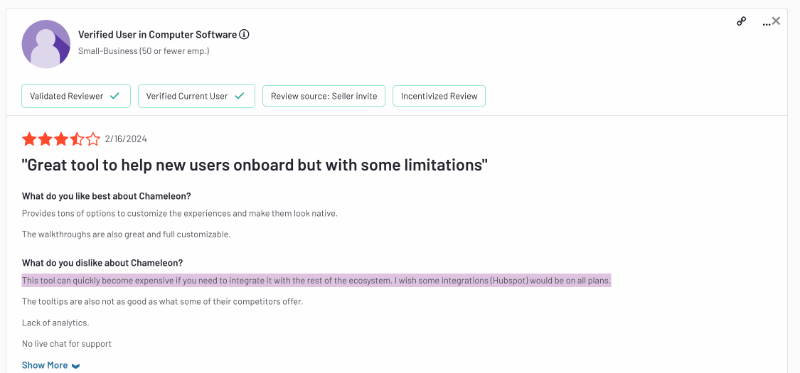
- Not for everyone: If you want to use Chameleon to its fullest potential, you’ll need to open up your wallet. Even if you stick with the Startup plan at its entry-level price, it’s still more expensive than many competitors.
So while it technically has a plan called Startup, and even a “free” plan in theory, Chameleon isn’t really built for startups or small businesses.
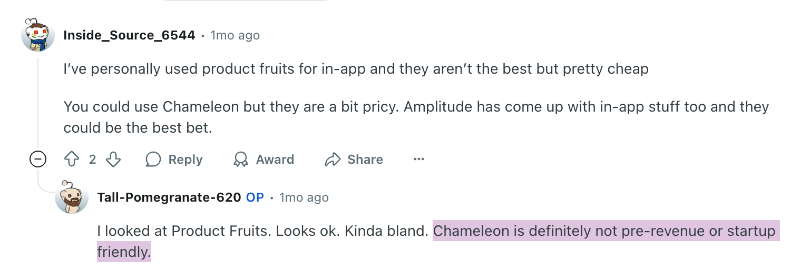
What are Chameleon’s pricing tiers?
Chameleon has 3 paid plans and a free plan, as we’ve just mentioned. The Startup plan, the lowest tier among the paid options, starts at $279/month. The Growth and Enterprise plans come with custom pricing.
How any of these plans, even Startup, scale with higher MAUs or expanded feature usage is unclear. But we’ve already touched on how that lack of transparency affects the overall experience.
So now, let’s break down what each plan actually offers and compare them based on what you get out of the plans in terms of features and capabilities 👇🏻
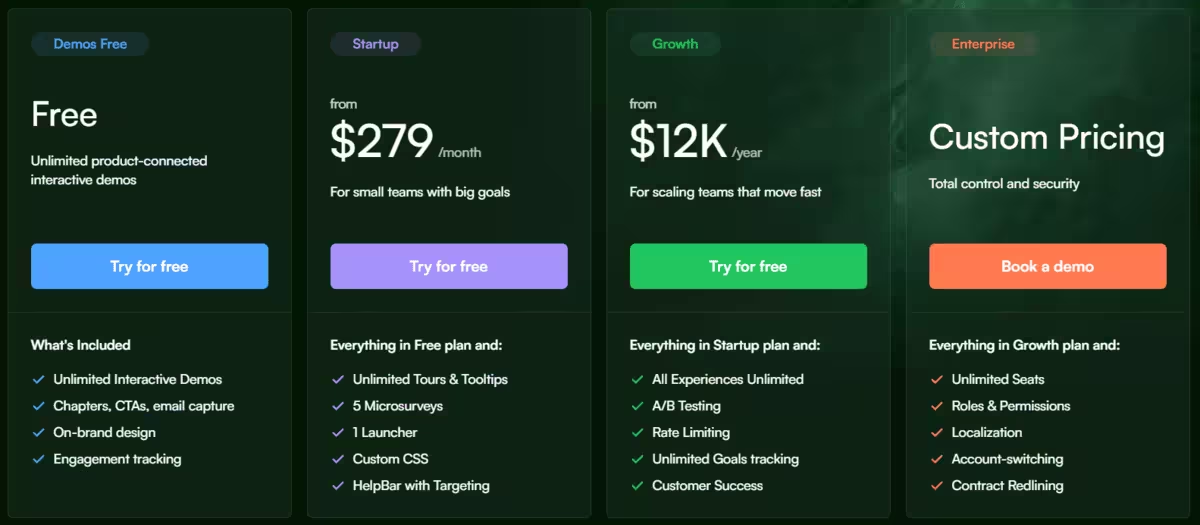
➡️ Demos Free
- Price: Free
- Features: Interactive demos
- Capabilities: Customization (for fonts and styling)
- Integrations: Webhooks (single trigger)
- Customer Services: Help center, Email support
➡️ Startup
- Price: Starting from $279/month
- Features: Tours (unlimited), Tooltips (unlimited), Embeddables (5), Microsurveys (5), Launchers (1), Tracked events (5), Experience reporting
- Capabilities: Segmentation, Dynamic Personalization, Event triggering
- Integrations: Segment, Slack, Intercom, Analytics tools, Webhooks (single trigger)
- Customer Services: Help center, Email support
➡️ Growth
- Price: Starting from $12,000/year
- Features: Everything in Startup (all unlimited except tracked events, which becomes 20), + A/B testing, Goal tracking (unlimited)
- Capabilities: Everything in Startup, + Granular rate limits (2), Custom alerts
- Integrations: Everything in Startup (Webhooks become all triggers), + Hubspot and Salesforce add-on availability
- Customer Services: Help center, Email support, Zoom support, implementation coaching (go-live plan), Success add-on availability (Bronze/Silver packages), Experience feedback (1/month)
➡️ Enterprise
- Price: Custom
- Features: Everything in Growth (Tracked events become 50)
- Capabilities: Everything in Growth (Granular rate limits become unlimited) , + Retrospective events, Localization
- Integrations: Everything in Growth (Salesforce and Hubspot integrations are included in the plan)
- Customer Services: Everything in Growth (success add-ons become Silver/Gold, and 1/month experience feedback become unlimited)
As you can see, Chameleon includes its core features across all plans. Even the Startup plan offers unlimited tours and tooltips, which makes it functionally solid for many SMBs –if you ignore the price.
For teams that don’t need add-ons or have no immediate plans to scale, the Startup plan provides more than enough to get started with in-app experiences.
The Growth plan builds on this by introducing more advanced capabilities for analytics and engagement monitoring, including unlimited tracked events, goal tracking, and A/B testing. This plan is best suited for companies that already have some in-app experience under their belt and are ready to optimize and scale.
There isn’t a radical leap between the Growth and Enterprise plans in terms of features.
However, access to localization and retrospective events can be game-changers, especially if you have a diverse user base or more advanced event tracking needs.
The absence of these key features in the Growth plan might be a dealbreaker for some, leading either to an upgrade... or churn 👻
What impacts Chameleon’s pricing tiers?
Though we don’t know exactly how much each factor influences your final contract price, here are the things that can potentially drive up your costs with Chameleon:
- Monthly Active Users (MAU)
- Number of seats/users on your team
- Plan tier (Startup, Growth, Enterprise)
- Add-ons and integrations
- Contract length and payment terms
- Feature usage and access to premium features
- Support level and services
- Custom event tracking volume
- SAML or security/compliance requirements
- Multi-product or multi-workspace usage
- Implementation or onboarding support needs
Is Chameleon Worth the Cost? (Pros & Cons)
Chameleon might have confusing, opaque, and expensive pricing, but plenty of customers still love the platform and feel the value they get far outweighs the cost. At the same time, there are customers who’ve run into other frustrations beyond pricing.
After all, while pricing matters, it’s not the only thing that drives a buying decision.
Here’s what (former) Chameleon customers love and hate about the platform 👇🏻
Pros of Chameleon
Let’s start with the good news, a.k.a. the advantages of Chameleon.
- Embeddables: There are two types of embeddables in Chameleon: inline banners and embedded cards. You can display up to 4 embedded cards at once, and customize them with visuals, videos, buttons, and links to trigger checklists, guides, or microsurveys.
You can also embed checklists or microsurveys directly.
Embedded elements like these aren’t widely offered by most product adoption or onboarding tools. And even when they are, like in Usetiful’s case, they’re often less customizable or less advanced than what Chameleon provides.
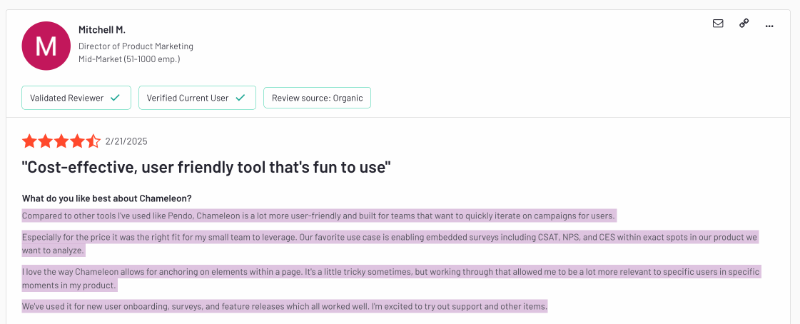
- Friendly CS team: Customer support and services aren’t widely available across all plans, they’re mostly reserved for higher-tier customers. That said, many Chameleon users describe the support team as responsive, friendly, and fast.
As for customer success and implementation training, those are also behind a paywall. But for those who do get access, the experience is generally seen as helpful and highly effective.

- Customization capabilities and templates: While certain customers criticize Chameleon’s customization capabilities, especially for microsurveys, many are content with them and find the platform very flexible.
Plus, you can save the steps you created for a tour as a template for future usage.

- AI recommendations: Chameleon’s AI analyzes the tours and embeddables you create and provides you with suggestions to improve and optimize them (only if you want). Here’s what the recommendations look like:
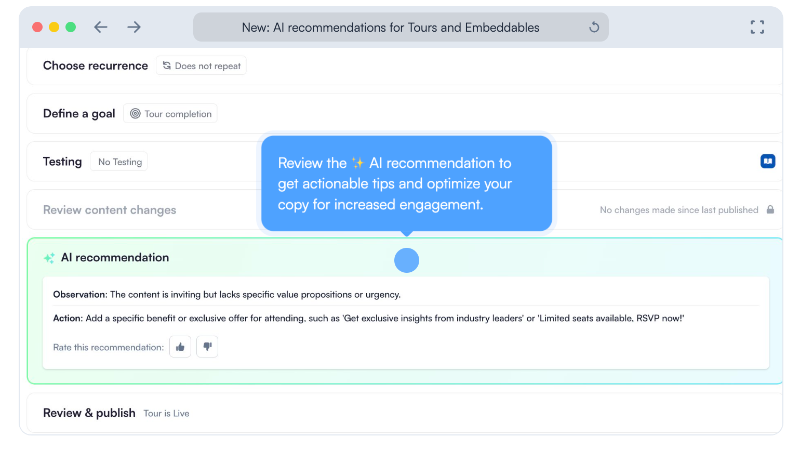
And here’s what Chameleon customers say about the feature:

Cons of Chameleon
Like any tool, Chameleon is far from being perfect. Here are some of its not-so-great aspects 👎🏻
- Has a learning curve (even for more technical teams): Chameleon isn’t a fully no-code tool, but it’s still considered low-code, especially when compared to its more complex alternatives like WalkMe.
That said, it does require some technical knowledge to set up and maintain.
But the challenge isn’t just technical. The platform also comes with a learning curve of its own. Some customers report that the combination of setup complexity and ongoing maintenance needs led them to depend heavily on their engineering teams.

- UX updates can feel mismatched and confusing: Chameleon does release regular updates, which some customers appreciate as a sign of the team’s commitment to improvement and user satisfaction.
However, not everyone sees it that way.
Some users feel confused or lost due to the frequency of changes, especially when UX/UI updates are rolled out partially, making the experience feel inconsistent and fragmented.
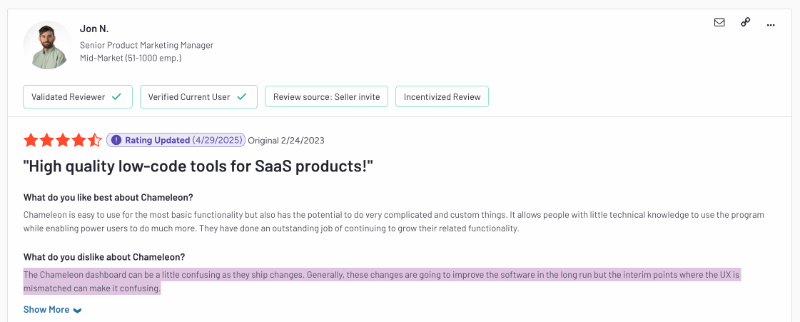
- Doesn’t pay off easily: We said we wouldn’t focus on price-related downsides here, but this one’s too important to skip.
If you can’t use Chameleon to its fullest, whether because of technical challenges, limited integrations, implementation hurdles, or any other reason, the price you pay starts to feel even more out of sync with what you’re actually getting.
The capability-to-price (C/P) ratio is barely balanced even when you fully utilize Chameleon. If you don’t, well... it takes a lot of justification to make that cost worth it.
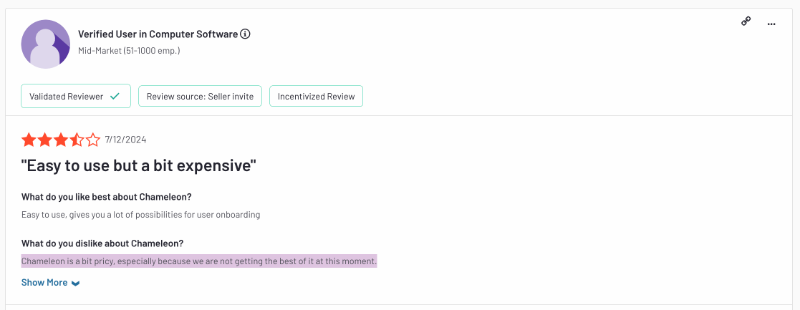
- Implementation can become tricky: In theory, Chameleon’s implementation is similar to other product adoption and onboarding platforms. However, in practice, many customers report challenges when integrating it with their products.
Some even compare Chameleon’s setup process to other similar tools and find it more confusing and difficult.
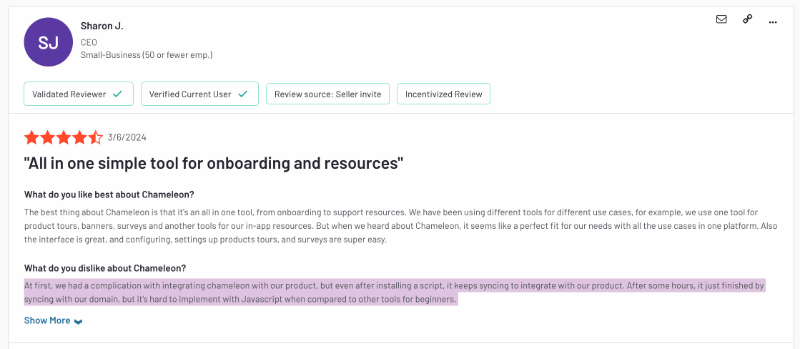
- Limited reporting: Chameleon’s analytics and reporting capabilities are more advanced than some alternatives like Product Fruits or Userflow. However, it’s still not the most sophisticated or best-in-class solution on the market.
Additionally, the platform’s engagement dashboards are not very intuitive.
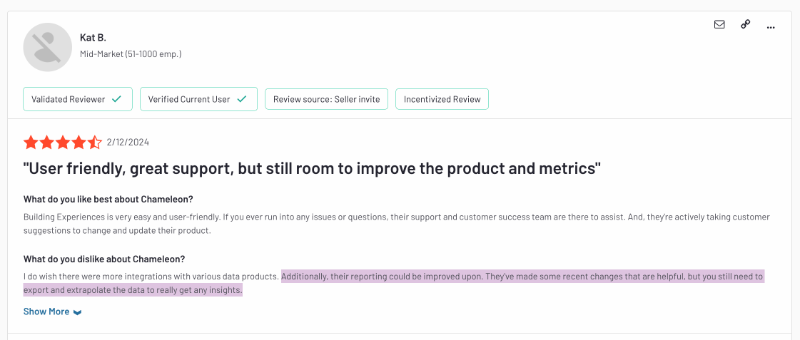
- Limited segmentation capabilities: Chameleon offers segmentation and dynamic personalization features; however, they can be difficult to use and sometimes feel buggy.
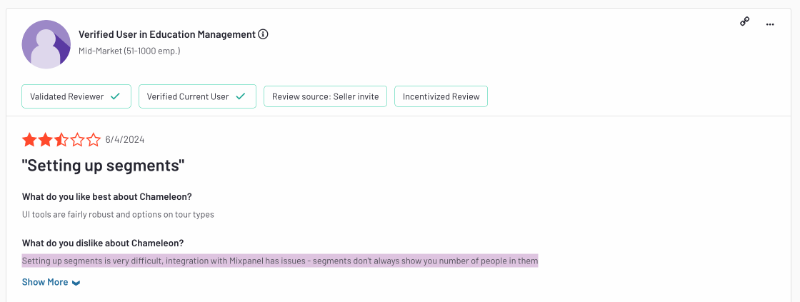
A better alternative to Chameleon: UserGuiding
UserGuiding is a no-code, all-in-one product adoption platform that empowers you with features and capabilities to engage with your users both within and outside your product.
With UserGuiding, you can create interactive onboarding flows, provide contextual guidance, offer automated and self-serve support (both in-app and off-app), communicate product updates (again, both in-app and off-app), conduct user research, and monitor user engagement, all from the same platform.
Here’s what UserGudinig offers in terms of features:
- Product tours
- Onboarding checklists
- Hotspots and tooltips
- Announcement modals (banners, slideouts, pop-ups, etc.)
- NPS and custom in-app surveys
- AI assistant
- Resource center (in-app)
- Knowledge base (standalone)
- Product updates (standalone)
- Segmentation
- Analytics
As you can see, beyond UserGuiding’s standalone features and AI assistant, which are already strong enough reasons to leave Chameleon behind, its overall offering looks quite similar to Chameleon’s at first glance.
So, let’s take a closer look and compare the two tools side by side 🔎
- Comprehensive feature set: UserGuiding doesn’t limit your communication and user engagement to in-app experiences. Instead, it offers two standalone platforms, a knowledge base and a product updates page, to help you communicate with customers, whether you're announcing updates or providing a comprehensive self-serve support hub.
Neither of these is offered by Chameleon.
Here’s what a knowledge base created with UserGuiding looks like:
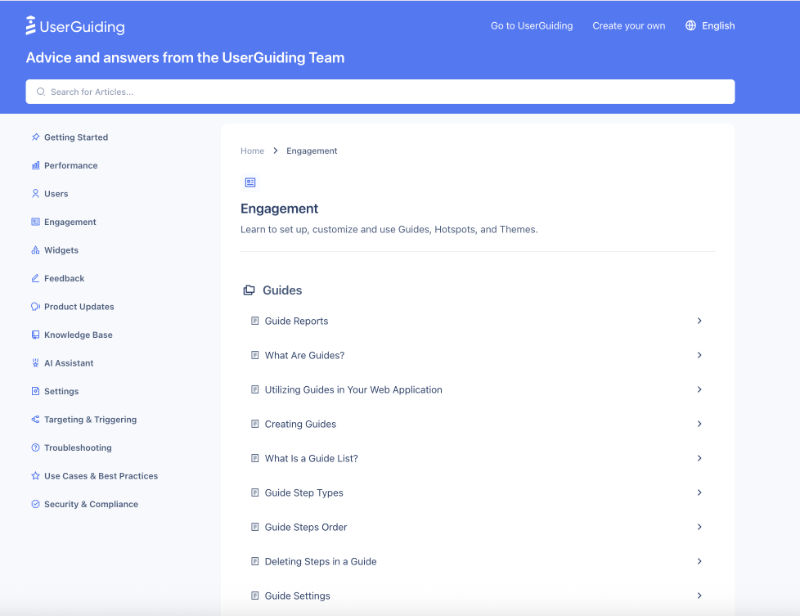
A knowledge base is a crucial part of any self-serve support system; it’s basically the heart that powers other support tools like AI agents or resource centers.
While Chameleon does offer a resource center, using it effectively means either manually entering help materials or relying on an integration with a separate knowledge base tool.
With UserGuiding, you get both the resource center and the knowledge base, no integration needed.
On top of that, you can create an AI agent that lives inside your product and connects directly to your knowledge base. This lets you deliver a complete, automated, self-serve support experience to customers who prefer quick, independent solutions over live support.

Another valuable feature that comes with UserGuiding is Product Updates, which lets you centralize your release notes and product announcements in one place.
In-app announcements are cool and engaging, but they’re often temporary and easy to miss. That’s why it’s important to keep a permanent, accessible record of your feature releases, UX/UI improvements, and bug fixes.
With a dedicated updates page, users always know where to look when they want to catch up on changes or revisit the details of a past release.
Here’s an example one created with UserGuiding:
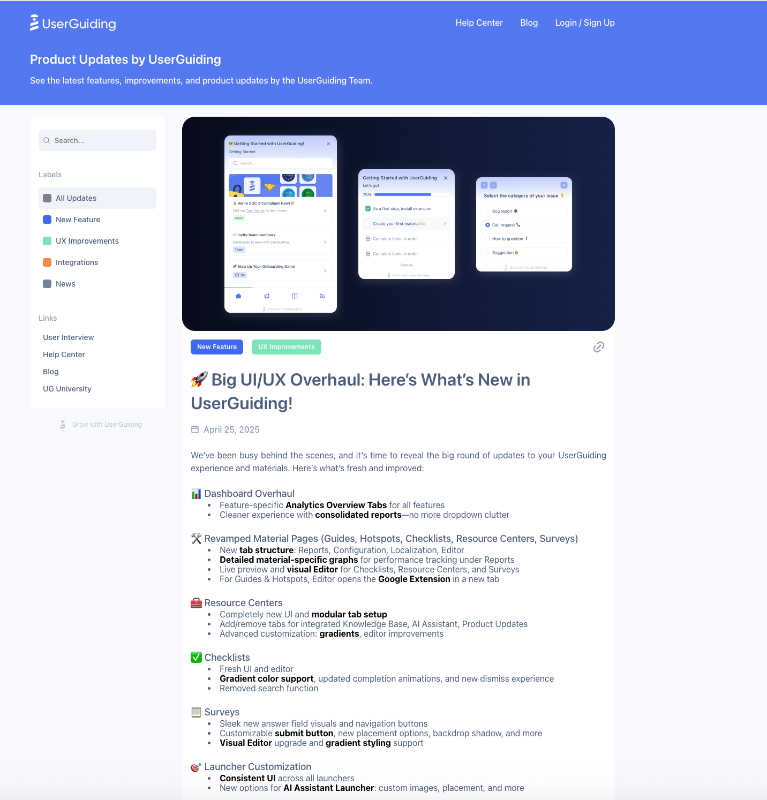
Product Updates also allow you to share more detailed information about your releases. With announcement modals or hotspots, space is limited, and you can't always go into specifics.
Cramming visuals, videos, or lengthy explanations into a tooltip about a new feature can also feel clunky and disrupt the user experience, especially if it's not the right moment for your users to dive in.
By keeping those details in your release notes, you ensure that users can easily access more in-depth information whenever they’re ready.
Plus, you can collect anonymous user feedback and emoji reactions on your updates, turning your announcements into a two-way communication channel.
- Customization and templates: Chameleon’s customization capabilities are a bit of a hot topic; some users love them, while others find them pretty limiting, especially when it comes to the templates in the feature builders.
When creating a flow or element in Chameleon, you have to start by choosing a template. But the available templates can feel blocky or even a bit outdated, depending on your design expectations. Plus, the variety is fairly limited, especially when compared to UserGuiding’s broader template library.
UserGuiding offers a rich selection of templates for tooltips, announcement modals, and in-app surveys. These templates are diverse, and not just in design, but also in use case and functionality, which gives you more flexibility and polish right out of the box.
- User segmentation: We’ve already mentioned Chameleon’s segmentation feature under its cons; it’s not the most flexible or user-friendly part of the platform.

UserGuiding, on the other hand, makes segmentation super straightforward and intuitive. You can create user segments based on:
- Material engagement
- User events
- User or company attributes
You can also combine conditions using both “AND” and “OR” logic, which gives you the flexibility to create very targeted segments.
The UI is pretty user-friendly for segmentation. You choose your criteria from a drop-down list, then add the details of your criteria. After that, you continue by adding more criteria or filters, and finally, save the segment.
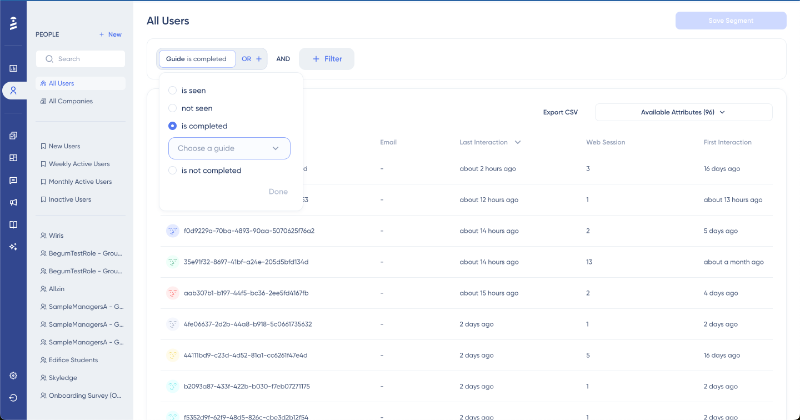
No coding, no technical complexity, just clear, step-by-step filtering.
As long as you know what you want to track and how you want to group your users, UserGuiding won’t get in your way.
Here’s what it looks like when you apply multiple rules to filter your user base:

- Performance dashboard: Both Chameleon and UserGuiding visualize user engagement through performance dashboards that track how your in-app experience materials perform. They both offer metrics on active content, user engagement levels, and provide weekly or monthly reports.
However, UserGuiding’s dashboards and reports are more detailed compared to Chameleon’s. For example, Chameleon’s engagement dashboards show how many users started and completed a guide, but they don’t provide a step-by-step breakdown to identify where users drop off or encounter friction.
UserGuiding, on the other hand, gives you a detailed step breakdown for each guide, so you can pinpoint exactly where users lose interest or get stuck.
Here’s how Chameleon’s dashboard looks:
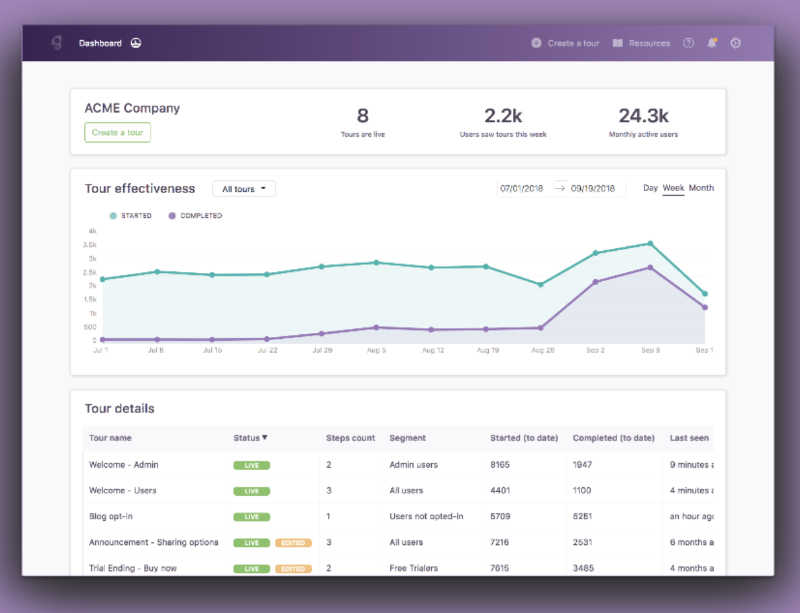
And here’s UserGuiding’s:
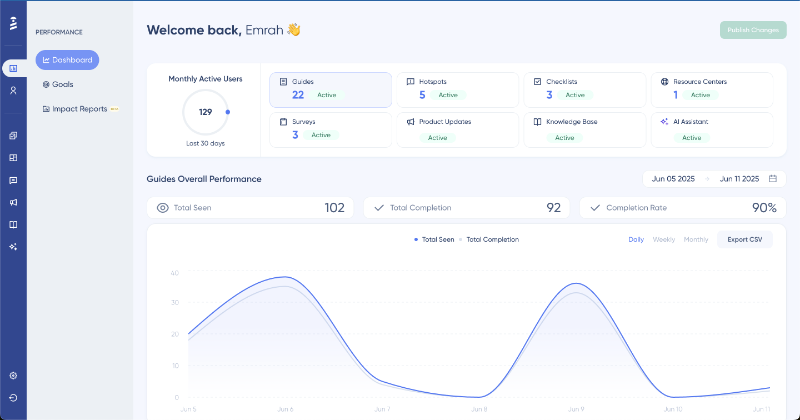
As you can see, UserGuiding’s dashboard gives you a full overview of all materials and their performance at a single glance. Chameleon’s dashboard, in contrast, focuses mainly on tours and lacks visibility into the performance of other material types.
Plus, UserGuiding highlights your top-performing and lowest-performing guides, helping you quickly identify what’s working and what needs attention.

- Usability: UserGuiding is a truly no-code solution with little to no learning curve and a fast implementation process, allowing you to start creating in-app experiences almost immediately. Chameleon, on the other hand, comes with a steeper learning curve, takes more time to set up, and often requires support, either from Chameleon’s team or your own technical team, to fully utilize certain features and capabilities.
We’ve already shown you what Chameleon’s customers have to say about the platform’s tricky implementation and setup. Now, here’s what UserGuiding customers are saying about their setup experience and overall usability:
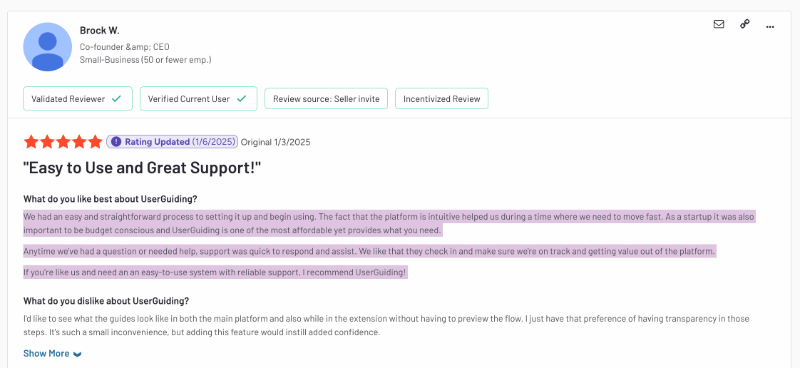
- Transparent price: UserGuiding not only offers more cost-effective plans and pricing, but it also provides a transparent, MAU-based pricing model, complete with a cost calculator directly on the pricing page, so you can easily estimate your potential expenses upfront.
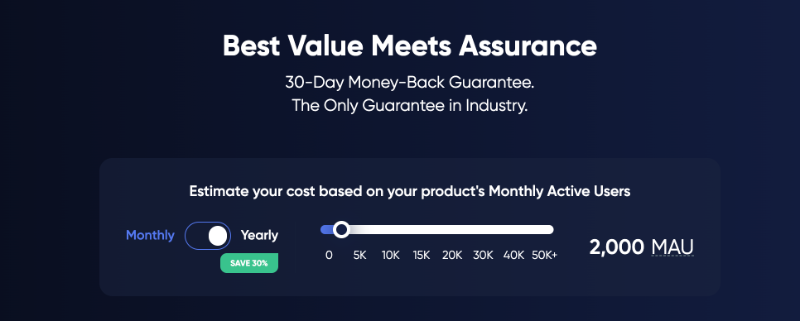
How much does UserGuiding cost?
UserGuiding has three paid plans (Starter, Growth, and Enterprise) and a free plan called Support Essentials. But before diving into the free offering, let’s break down the paid plans, what they include, and how they scale.
The Starter plan begins at $174/month (billed annually) for up to 2,000 MAU. The Growth plan starts at $349/month (also billed annually) for the same MAU limit. If you bump your MAU from 2,000 to 5,000, those prices go up to $209/month and $419/month, respectively, still billed annually.
UserGuiding also offers a monthly billing option for all paid plans. While annual billing saves you around 30% over the course of a year, it’s nice to have the flexibility if you’d rather pay month to month.
Chameleon offers a monthly billing option only for the Startup plan.
UserGuiding’s Starter plan gives you access to core features like interactive guides, checklists, hotspots, surveys, a resource center, and basic analytics. While there are limits on how many live materials you can have, it still supports the essential elements of a solid user onboarding and engagement setup.
The Growth plan, on the other hand, is designed for teams that need greater flexibility and deeper insights.
It lifts many of the material restrictions and adds advanced capabilities like custom CSS, A/B testing, goal tracking, and localization support, allowing teams to fine-tune and optimize their user experience more effectively.
Both plans also come with 50 free AI assistant resolutions.
↩️ Now, let’s circle back to the free plan: Support Essentials.
This plan is tailored for teams looking to automate and enhance their customer support. It includes all of UserGuiding’s customer support features, such as the resource center, knowledge base, product updates, AI assistant (with 50 free resolutions), material engagement analytics, and daily/weekly performance reports.
However, it doesn’t provide access to in-app experience tools like tooltips, hotspots, checklists, surveys, or guides; those are only available on paid plans.
UserGuiding also offers a 14-day free trial.
Final Thoughts: Choosing the Right Plan or Alternative
We’ve covered a lot, so if your brain’s feeling a little mushy and you’re not quite sure how to feel about Chameleon anymore, that’s totally valid.
Here’s the gist:
👉 You might still want to talk to Chameleon and try to wrangle yourself a decent deal if:
- You love embedded modals and want more than the usual pop-up options for your in-app experiences. Chameleon shines here; not many platforms offer this many embeddables. Just remember, you’re limited both by your plan and how many you can use at once.
- You’re into the CMD+K Search feature and prefer it over the AI agents other tools (like UserGuiding or Userflow) offer. It’s definitely a neat touch, but let’s be real, it’s less interactive than a chatbot and not nearly as helpful as a standalone knowledge base.
- You want to save your flows as templates for future use. But saving templates means you always have to use one to build new content. And Chameleon’s template selection? A little stiff and outdated for some tastes. So don’t get too hyped unless you’re okay with working within those blocks.
💡 On the flip side, you should seriously consider a Chameleon alternative like UserGuiding if:
- You want to manage both in-app and off-app user engagement from one place.
- You don’t have time to deal with lengthy setups, support tickets, or chasing down your dev team. You want a truly no-code solution that you can just… use.
- You’d rather not play pricing roulette and prefer a transparent, cost-effective plan that actually feels fair.
- You want more creative freedom when it comes to customization and design.
So yeah… doesn’t feel like such a hard decision now, does it?
UserGuiding just makes more sense.
Frequently Asked Questions
How much does Chameleon cost for product-led growth teams in 2025?
Chameleon does not publicly share how its pricing scales based on MAUs or feature usage, and most plan details are kept vague. The only concrete information available is that the Startup plan starts at $279/month, and their Interactive Demos are available through a separate free plan called Demos Free. The Growth tier starts from $12,000 and is billed yearly while the Enterprise tier is quote-based. According to Vendr data, though, Chameleon’s average yearly cost surpasses $30,000, which makes it one of the more expensive platforms for PLG teams.
How do Chameleon’s pricing plans compare: Startup, Growth, and Enterprise tiers?
Chameleon’s pricing tiers vary widely in capability. The Startup plan includes core features but comes with limited access to advanced functionalities like A/B testing or goal tracking. The Growth plan unlocks more customization and data features, while the Enterprise tier adds premium support and scalability features. However, the exact pricing for Growth and Enterprise is not disclosed, which can make it harder to evaluate value unless you go through a full sales process.
What features are included in each Chameleon plan?
The Startup plan gives access to basic product tours and in-app messages but lacks advanced analytics, experimentation tools, and most integrations. These are reserved for Growth and Enterprise plans. Growth includes features like A/B testing, custom CSS, goal tracking, and localization. Enterprise plans are more flexible and come with premium support and service-level agreements. The Demos Free plan, while free, includes limited capabilities and does not support any of Chameleon’s core onboarding features.
How does Chameleon compare with Appcues and UserGuiding for onboarding tools in terms of pricing?
Chameleon and Appcues start at similar prices, $279 and $300 per month, respectively, while UserGuiding starts at $249/month. Although both Chameleon and UserGuiding have free plans, only UserGuiding’s offers multiple features designed around customer support automation. Chameleon’s free plan offers just Interactive Demos, which cannot stand alone. UserGuiding also remains more affordable as your MAU grows, whereas Appcues becomes much more expensive, and Chameleon’s pricing model is less predictable but known to scale steeply.
Is Chameleon’s pricing model flexible for early-stage SaaS companies?
Not really. Chameleon’s pricing lacks transparency and flexibility, which can make it less appealing for early-stage startups. With unclear scaling and high average costs, it may require negotiation and a larger budget than more startup-friendly alternatives.

















.svg)
.svg)
.svg)
.svg)
.svg)

.svg)
.svg)












.svg)
.svg)





.png)
